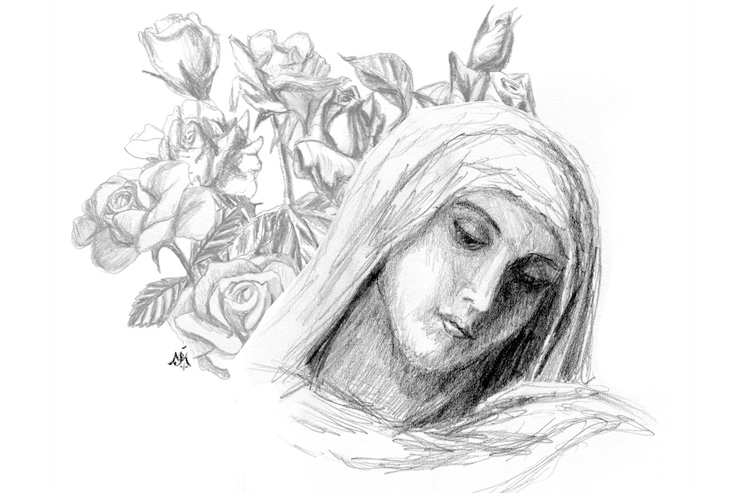An extraordinary tale is spun by the second century heretic, Marcion, in his understanding of the story of Salvation History, which he arrives at through an assiduous, yet flawed reading of Sacred Scripture. Although he was denounced by many of the Church Fathers who were his contemporaries, Marcion essentially taught that everything was created by an evil god, which he called the Demiurge, and therefore all matter, even the bodies of humans, was evil. By the mercy of another Deity, the supreme and good God of Love, who had compassion on the humans suffering under the Demiurge, Jesus appears, literally appears without the virgin birth, on the planet and frees mankind from the Demiurge. By faith in the good God and rejection of the bad god, humans are able to escape the material world and go to heaven.
This Gnostic rendering of the Bible led Marcion to the belief in two gods, the evil god of the Old Testament and the Good God of the New. Confused by the seemingly contradicting behaviors of God in each Testament, he ignored the prophetic connection between the two Testaments and declared his own canon of Scripture to back up his theology. His teaching grew in popularity and gathered attention from teachers like St. Justin Martyr, who condemned Marcion for “teaching men to deny that God is the maker of all things in heaven and earth and that the Christ predicted by the prophets is His Son” (1 Apology 58).
Marcion dies around 150 A.D. and the heresy which carried his name disappears after the seventh century. However, within the Catholic Church’s prodigious history we see heresies come and go and then return under new names and in new forms. Once again in our own day, forms of Marcionism have reared their ugly heads through the denial of a connection between the Old Testament and the New Testament. Many people falsely interpret the Scriptures, forgetting the Hermeneutic of Canonicity, to claim that there is a rift between the Old and New Testaments. These misinformed readers once again misunderstand the work of God depicted in the Bible.
One example of misinterpretation is seen with the ceremonial law of the Israelites given in the Book of Leviticus which states that the Jews shall not eat shellfish. While binding on the Hebrew people of the time, this ceremonial law, which is different than the lasting Moral law, is no longer obligatory to the faithful. The ceremonial laws were meant to purify the Jews of the various attachments they had to pagan gods, especially Egyptian gods, and prepare them for the coming Messiah. It is true that there seems to be a difference in God’s dealings with humanity, but is it really God who is changing?
The Church teaches that God is immutable, unchangeable, He Who Is (CCC 212). Even though it seems like God “changes” in the story of our Salvation, it is actually human beings and our relationship with God that is changes. What this means is that, because of our existence in the temporal world and our experience of change, what we read of in the Scriptures is the adapting human perception and understanding of the One Who Is. This is similar to someone riding in a car and passing a barn on the side of the road. The person could assume that the barn is moving, but in actuality it is only the car that is is moving with the person inside.
Another good analogy for this is seen with the constantly burning and ever present Sun. Relatively, the Sun never moves. It is always present to the Earth. Additionally, the Sun more or less does not change in temperature or intensity of light as it remains a continuous source of heat and illumination for the Earth.
It is not the Sun therefore, but the Earth’s position and proximity to the Sun, that causes the change in the experience of heat and light on the Earth. As the Earth spins and rotates throughout its 365-day journey around the Sun, seasons come and go due to which hemisphere is tilted toward the Sun. It is the same heat and sunlight each day. However, the Earth does experience many changes due to its position relative to the Sun.
Similar to this reality, our Heavenly Father’s love for us does not change. Like the light and heat of the Sun, His love lands upon each of us in the same way. Mysteriously, it is the effects of this eternal Love on each soul that change. When the soul is more disposed to God, living in Charity and the state of Grace, like the places on Earth tilted toward the Sun, the soul is left warm and able to bear fruit. Like a nice summer day teaming with joggers, bikers, and kids at the pool, it is filled with more life and joy.
So it is with humanity’s journey through time. God’s love has been ever-burning and unchanging from the beginning. In fact, in the beginning we can see great similarities between man and woman’s experience with God in the Garden of Eden and our experience with Him in the Garden that is the Church.
The chief consequence of Original Sin was the privation of Sanctifying Grace which Christ has won back for us on the cross and dispenses to us through the Sacraments. While still having some other effects of Original Sin, like concupiscence, death, and suffering, we are still much closer to the Eden experience than the Israelites were. Furthermore, we can now have even more than Adam and Eve through the opened gates of heaven.
If we look at Salvation History in this way, seeing that God is in fact forming a fallen humanity to receive the gifts that were originally intended yet lost through sin, it is easier to recognize the rigid work of God and its impact on the changing state of human beings. His immutability further brings to light the truth of each one of us never losing His everlasting love, no matter how we change or where we go. We have a Father who loves us always and forever.














